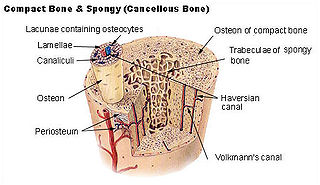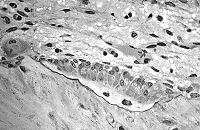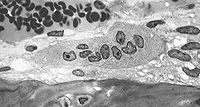
Osseous tissue
Encyclopedia

Connective tissue
"Connective tissue" is a fibrous tissue. It is one of the four traditional classes of tissues . Connective Tissue is found throughout the body.In fact the whole framework of the skeleton and the different specialized connective tissues from the crown of the head to the toes determine the form of...
of the body. Osseous tissue forms the rigid part of the bone
Bone
Bones are rigid organs that constitute part of the endoskeleton of vertebrates. They support, and protect the various organs of the body, produce red and white blood cells and store minerals. Bone tissue is a type of dense connective tissue...
organs that make up the skeletal system.
Formation
Bone tissue is a mineralized connective tissueMineralized tissues
Mineralized tissues are biological tissues that incorporate minerals into soft matrices. Typically these tissues form a protective shield or structural support...
. It is formed by cells, called osteoblast
Osteoblast
Osteoblasts are mononucleate cells that are responsible for bone formation; in essence, osteoblasts are specialized fibroblasts that in addition to fibroblastic products, express bone sialoprotein and osteocalcin.Osteoblasts produce a matrix of osteoid, which is composed mainly of Type I collagen...
s, that deposit a matrix of Type-I collagen
Type-I collagen
Type-I collagen is the most abundant collagen of the human body.It is present in scar tissue, the end product when tissue heals by repair.It is found in tendons, the endomysium of myofibrils and the organic part of bone.- See also :* Collagen...
and also release calcium, magnesium, and phosphate ions that ultimately combine chemically within the collagenous matrix into a crystalline mineral, known as bone mineral
Bone mineral
Bone mineral is the inorganic component of bone. Bone mineral is formed from carbonated hydroxyapatite with lower crystallinity....
, in the form of hydroxyapatite. The combination of hard mineral and flexible collagen makes bone harder and stronger than cartilage
Cartilage
Cartilage is a flexible connective tissue found in many areas in the bodies of humans and other animals, including the joints between bones, the rib cage, the ear, the nose, the elbow, the knee, the ankle, the bronchial tubes and the intervertebral discs...
without being brittle. Compact bone consists of a repeating structure called a Haversian system
Osteon
The osteon, or Haversian system, is the fundamental functional unit of much compact bone. Osteons, roughly cylindrical structures that are typically several millimeters long and around 0.2mm in diameter, are present in many of the bones of most mammals, birds, reptiles, and amphibians.Each osteon...
, or osteon, which is the primary anatomical and functional unit. Each osteon has concentric layers of mineralized matrix, called concentric lamellae, which are deposited around a central canal, also known as the Haversian canal, each containing a blood and nerve supply.



Types
There are two types of osseous tissue: compactCortical bone
Cortical bone, synonymous with compact bone, is one of the two types of osseous tissue that form bones. Cortical bone facilitates bone's main functions: to support the whole body, protect organs, provide levers for movement, and store and release chemical elements, mainly calcium. As its name...
and spongy. Compact tissue is synonymous with cortical bone, and spongy tissue is synonymous with trabecular and cancellous bone. Compact bone forms the extremely hard exterior while spongy bone fills the hollow interior. The tissues are biologically identical; the difference is in how the microstructure is arranged.
Functions
Osseous tissue performs numerous functions including:Directly:
- Support for muscleMuscleMuscle is a contractile tissue of animals and is derived from the mesodermal layer of embryonic germ cells. Muscle cells contain contractile filaments that move past each other and change the size of the cell. They are classified as skeletal, cardiac, or smooth muscles. Their function is to...
s, organOrgan (anatomy)In biology, an organ is a collection of tissues joined in structural unit to serve a common function. Usually there is a main tissue and sporadic tissues . The main tissue is the one that is unique for the specific organ. For example, main tissue in the heart is the myocardium, while sporadic are...
s, and soft tissues. - Leverage and movement.
- Protection of vital organs, e.g., the heart. (Note: not all vital organs are protected by bones, e.g., the intestines.)
- Calcium phosphateCalcium phosphateCalcium phosphate is the name given to a family of minerals containing calcium ions together with orthophosphates , metaphosphates or pyrophosphates and occasionally hydrogen or hydroxide ions ....
storage.
Indirectly:
- Hemopoiesis - formation of blood cells by the bone marrowBone marrowBone marrow is the flexible tissue found in the interior of bones. In humans, bone marrow in large bones produces new blood cells. On average, bone marrow constitutes 4% of the total body mass of humans; in adults weighing 65 kg , bone marrow accounts for approximately 2.6 kg...
interspersed within the spongy bone.
Osseous tissue versus bones
Bone tissue is different from bones themselves — bones are organs made up of bone tissue as well as marrow, blood vessels, epithelium and nerves, while bone tissue refers specifically to the mineral matrix that form the rigid sections of the organ.See also
- PeriosteumPeriosteumPeriosteum is a membrane that lines the outer surface of all bones, except at the joints of long bones. Endosteum lines the inner surface of all bones....
- Bone healingBone healingBone healing, or fracture healing, is a proliferative physiological process in which the body facilitates the repair of a bone fracture....
- OsseointegrationOsseointegrationOsseointegration derives from the Greek osteon, bone, and the Latin integrare, to make whole. The term refers to the direct structural and functional connection between living bone and the surface of a load-bearing artificial implant...
- OsteocyteOsteocyteAn osteocyte, a star-shaped cell, is the most abundant cell found in compact bone. Cells contain a nucleus and a thin ring of cytoplasm. When osteoblasts become trapped in the matrix they secrete, they become osteocytes...
- OsteoblastOsteoblastOsteoblasts are mononucleate cells that are responsible for bone formation; in essence, osteoblasts are specialized fibroblasts that in addition to fibroblastic products, express bone sialoprotein and osteocalcin.Osteoblasts produce a matrix of osteoid, which is composed mainly of Type I collagen...
- OsteoclastOsteoclastAn osteoclast is a type of bone cell that removes bone tissue by removing its mineralized matrix and breaking up the organic bone . This process is known as bone resorption. Osteoclasts were discovered by Kolliker in 1873...
- Red bone marrow
- HydroxylapatiteHydroxylapatiteHydroxylapatite, also called hydroxyapatite , is a naturally occurring mineral form of calcium apatite with the formula Ca53, but is usually written Ca1062 to denote that the crystal unit cell comprises two entities. Hydroxylapatite is the hydroxyl endmember of the complex apatite group...
Sources
- Henry Gray: Anatomy of the human body (Bartleby.com; Great Books Online)
- Eldra P. Solomon - Richard R. Schmidt - Peter J. Adragna : Human anatomy & physiology ed. 2nd 1990 (Sunders College Publishing, Philadelphia) ISBN 0 03 011914 6

